七年级英语上册复习学案(全册)人教新课标
- 格式:doc
- 大小:111.00 KB
- 文档页数:12
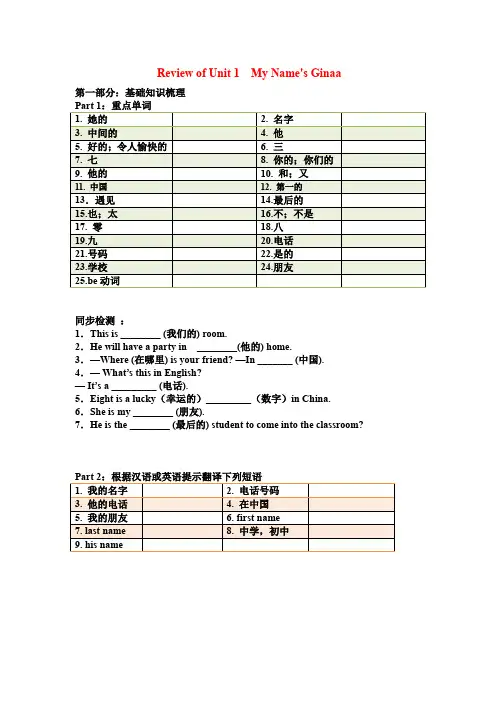
Review of Unit 1 My Name's Ginaa第一部分:基础知识梳理同步检测:1.This is ________ (我们的) room.2.He will have a party in ________(他的) home.3.—Where (在哪里) is your friend? —In _______ (中国). 4.— What’s this in English?— It’s a _________ (电话).5.Eight is a lucky(幸运的)_________(数字)in China. 6.She is my ________ (朋友).7.He is the ________ (最后的) student to come into the classroom?同步检测:Good morning,class. I’m your English teacher this year(年). Now let me introduce myself to you(首先让我介绍一下我自己).My 1. is Angel, and Lee is my 2. . I have taught(教)in this 3. for two years. If(如果)you want to talk to me, you can call me. My 4. is 137-1744-0447. Thank you and 5. . Let’s be friends!书面表达Unit 1 我的好朋友假如你有一位英国朋友叫Alan Smith,请根据下表中的提示信息写一份关于他的可能用到的短语或句型介绍人物身份:He is .../ His name is .../first name名/ last name姓介绍电话号码:His phone number is ...介绍年龄:He is ...介绍学校: He is in ....middle school 他在.......中学My good friendI have a good friend. His name is Alan Smith. He's an English boy. He’s twelve years old. Alan is a student. He’s in NEC Middle School. There are four people in his family--his parents, his sister and he. They live in a small city. Alan’s phone number is 662-3398. I always email him at alan2020 @ gfimail. com.I love being friends with him. We can talk about and share everything.Do you want to know him?第二部分:当堂检测一、单项选择。
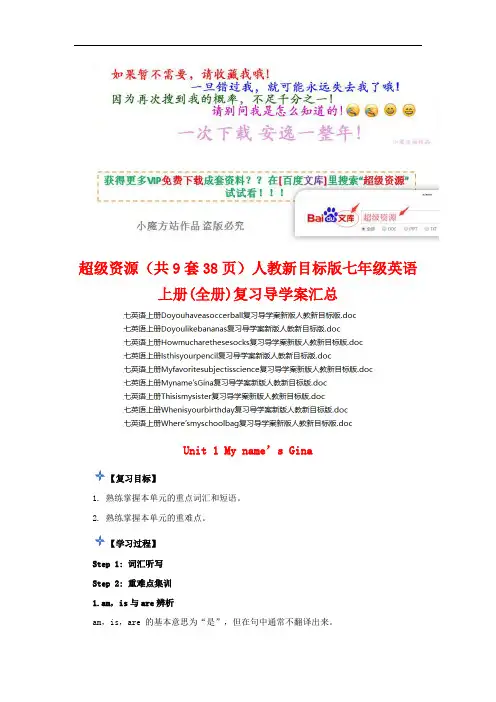
超级资源(共9套38页)人教新目标版七年级英语上册(全册)复习导学案汇总Unit 1 My name’s Gina【复习目标】1. 熟练掌握本单元的重点词汇和短语。
2. 熟练掌握本单元的重难点。
【学习过程】Step 1: 词汇听写Step 2: 重难点集训1.am,is与are辨析am,is,are 的基本意思为“是”,但在句中通常不翻译出来。
★be动词记忆口诀:I用___________,you 用___________,___________ 连着他(he)她(she)它(it)。
单数名词用___________,复数名词用___________。
变疑问,___________,句末问号莫丢弃;变否定,更容易,be 后___________莫忘记;疑问否定任你变,句首大写莫迟疑。
★be动词与人称代词或疑问词构成的缩略形式:I am = ___________ he is = ___________ she is = ___________it is =___________ we are =___________ you are =___________they are =___________ what is = ___________where is = ___________【注意】this和is一般不缩写。
Ⅰ.用be动词的适当形式填空。
1.—How _________ you?—I _________fine.2.—What _________ that in English?—It _________ a pen.3.She and I _________ in China.4.—Who _________ Mr.Webb?—He _________ Jane's father.Ⅱ.按要求完成下列句子5.I'm Mary Miller.(改为一般疑问句)__________________ Mary Miller?6.His first name is Tom.(改为缩略形式)His first _________Tom.7.Is she Linda?(作否定回答)__________________8.I'm Jim Green.(改为同义句)_________________________2.no与not辨析★no可作副词,用于否定的回答或陈述;也可作形容词,直接用于名词前。
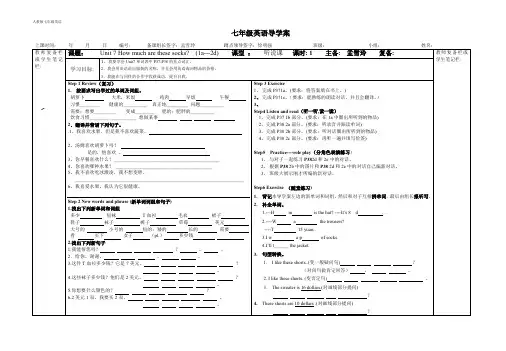
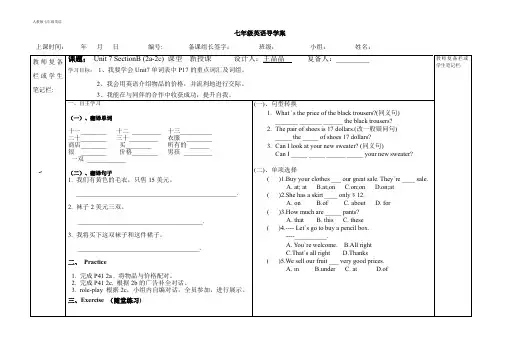
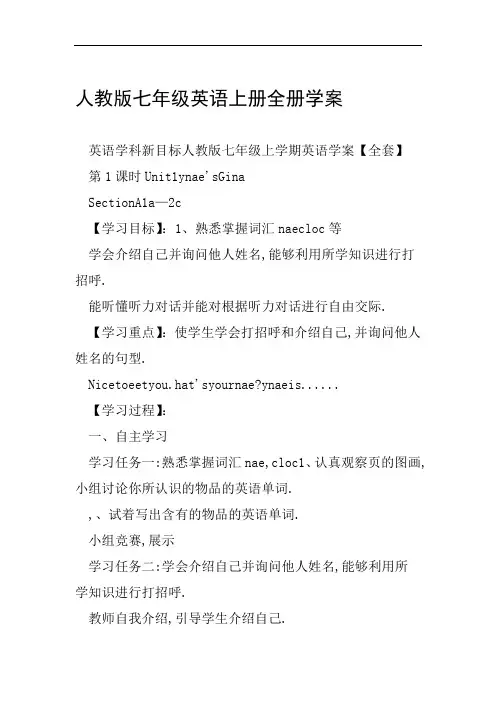
人教版七年级英语上册全册学案英语学科新目标人教版七年级上学期英语学案【全套】第1课时Unit1ynae'sGinaSectionA1a—2c【学习目标】:1、熟悉掌握词汇naecloc等学会介绍自己并询问他人姓名,能够利用所学知识进行打招呼.能听懂听力对话并能对根据听力对话进行自由交际.【学习重点】:使学生学会打招呼和介绍自己,并询问他人姓名的句型.Nicetoeetyou.hat'syournae?ynaeis......【学习过程】:一、自主学习学习任务一:熟悉掌握词汇nae,cloc1、认真观察页的图画,小组讨论你所认识的物品的英语单词.,、试着写出含有的物品的英语单词.小组竞赛,展示学习任务二:学会介绍自己并询问他人姓名,能够利用所学知识进行打招呼.教师自我介绍,引导学生介绍自己.A:Hello,IaGina,hat'syournae?B:ynaeisAlan.小组竞赛,两人一组,询问他人姓名,介绍自己.,、分角色朗读1A对话.学习任务三:能听懂听力对话并能对根据听力对话进行自由交际.,、听录音,给1B的对话编号.根据听力对话进行自由交际.小组竞赛,展示对话交际。
二、合作共建小组讨论我们所学的英语名字和汉语名字的区别,如何用英语拼写你的名字?三、系统总结,、归纳你所学到的问候语.自己编写一个打招呼并询问姓名的小对话.四、诊断评价单项选择._______yournae?ynaeisGina.A.hatB.hat'sc.hoD.hichGoodorning,issang!_____________!A.HelloB.Hic.NicetoeetyouD.GoodorningI_______Sally,hat______yournae?A.a,isB.is,ac.is,isD.a,a______naeisLilei.A.IB.Iac.yD.you—_______,hat'syournae?—johnGreen.A.HiB.oc.sorryD.Excusee写出下列单词的完全形式,并写出汉语意思.I'___________________hat's__________________nae's_____________________写出下列单词.时钟_______我的________你的___________名字_______遇见_________尝试翻译下列句子.见到你很高兴._________________________________.我叫王小雨.____________________________________.你叫什么名字?____________________________________ 根据情景补全对话.A:Goodafternoon!B:____________________!A;I______Lucy._________yournae?B:y______isji.Niceto______you!A:_______________________________.五、【课后反思】任务熟练掌握基本掌握没掌握第2课时Unit1ynae'sGina.SectionA【学习目标】:1、熟练掌握本课6个单词.学会询问他人姓名及介绍他人姓名.能听懂有关谈论他人姓名的对话并进行自由交际.【学习重点】:询问他人姓名及介绍他人姓名的句型.一、自主学习学习任务一:熟练读写本课6个单词..个人自渎,记忆本课单词..小组互相检查单词读写情况..根据汉语写出下列英语单词并展示.学习任务二:运用句型:hat'shis/hernae?His/Hernaeis....进行自由交际..小组合作,理解并熟读下列短语,并写出汉语意思. ynaneyournaehisnaehernae个人理解下列对话,并且两人合作练习.A:Hello!hat'syournae?ynaeisGina.B:A:Nicetoeetyou.B:Nicetoeetyou,too.A:hat'shernae?B:Hernaeisjenny.小组合作,练习自己的对话.对抗组开展竞赛,展示自己的对话.学习任务三:听听力完成2a,2b.个人看图,理解四幅图画,思考图画中人是在谈论他人还是对方.听听力,给四幅图画编号.小组为单位,熟读2b中的名字。
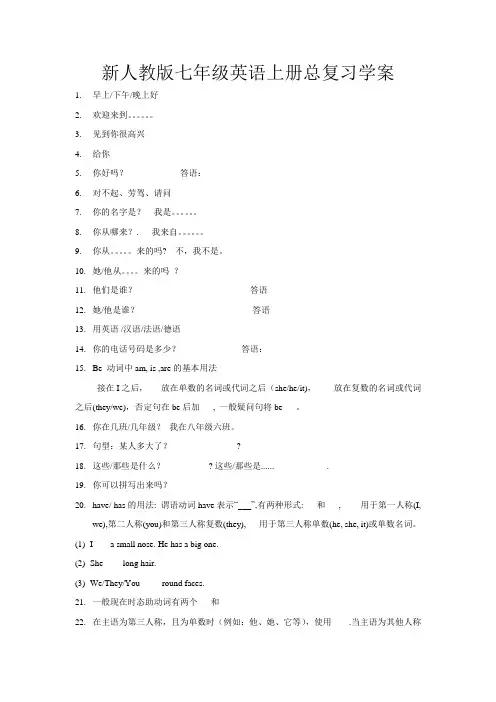
新人教版七年级英语上册总复习学案1.早上/下午/晚上好________2.欢迎来到。
________3.见到你很高兴________4.给你___________5.你好吗?____________答语:__________________6.对不起、劳驾、请问_________________7.你的名字是?我是。
__________________________8.你从哪来?. 我来自。
9.你从。
来的吗? 不,我不是。
_____________________________10.她/他从。
来的吗?______________________11.他们是谁?________________________答语__________________12.她/他是谁?_________________________答语___________________13.用英语 /汉语/法语/德语______________________14.你的电话号码是多少?_____________ 答语:________________15.Be 动词中am, is ,are的基本用法____接在I之后,___放在单数的名词或代词之后(she/he/it),___ 放在复数的名词或代词之后(they/we),否定句在be后加___, 一般疑问句将be___。
16.你在几班/几年级?我在八年级六班。
___________________________17.句型:某人多大了?_______________?18.这些/那些是什么?__________? 这些/那些是......____________.19.你可以拼写出来吗?_______________________20.have/ has的用法: 谓语动词have表示“___”,有两种形式:___和___, ____用于第一人称(I,we),第二人称(you)和第三人称复数(they),___用于第三人称单数(he, she, it)或单数名词。
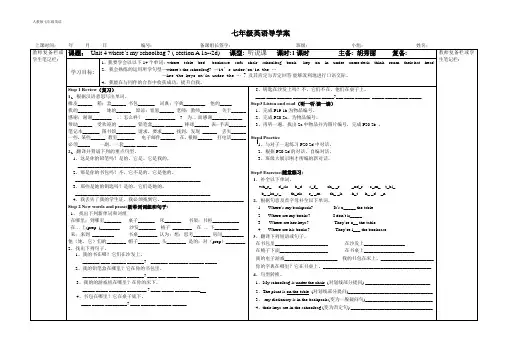
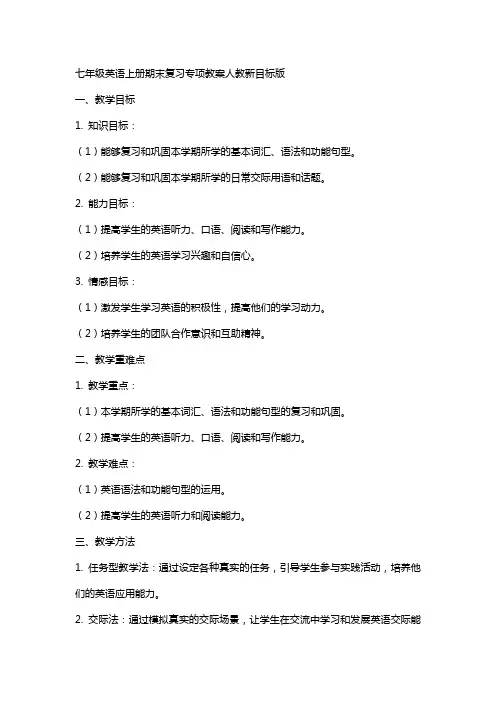
七年级英语上册期末复习专项教案人教新目标版一、教学目标1. 知识目标:(1)能够复习和巩固本学期所学的基本词汇、语法和功能句型。
(2)能够复习和巩固本学期所学的日常交际用语和话题。
2. 能力目标:(1)提高学生的英语听力、口语、阅读和写作能力。
(2)培养学生的英语学习兴趣和自信心。
3. 情感目标:(1)激发学生学习英语的积极性,提高他们的学习动力。
(2)培养学生的团队合作意识和互助精神。
二、教学重难点1. 教学重点:(1)本学期所学的基本词汇、语法和功能句型的复习和巩固。
(2)提高学生的英语听力、口语、阅读和写作能力。
2. 教学难点:(1)英语语法和功能句型的运用。
(2)提高学生的英语听力和阅读能力。
三、教学方法1. 任务型教学法:通过设定各种真实的任务,引导学生参与实践活动,培养他们的英语应用能力。
2. 交际法:通过模拟真实的交际场景,让学生在交流中学习和发展英语交际能力。
3. 情境教学法:通过创设各种情境,让学生在实际语境中学习和运用英语。
四、教学准备1. 教学材料:人教新目标版七年级英语上册教材、多媒体教学设备。
2. 教学工具:PPT、音频、视频等教学资源。
五、教学过程1. 热身活动(5分钟):(1)教师与学生进行简单的英语对话,检查学生的英语水平。
(2)学生进行小组活动,用英语进行自我介绍和交流。
2. 复习环节(15分钟):(1)教师带领学生复习本学期所学的基本词汇和语法。
(2)学生进行小组活动,互相测试和复习所学知识。
3. 听力训练(15分钟):(1)教师播放听力材料,学生进行听力练习。
(2)学生回答听力问题,教师进行讲解和反馈。
4. 阅读训练(15分钟):(1)教师分发阅读材料,学生进行阅读练习。
(2)学生回答阅读问题,教师进行讲解和反馈。
5. 写作训练(10分钟):(1)教师给出写作话题,学生进行写作练习。
(2)学生互相交换写作作品,进行互相评价和反馈。
6. 总结环节(5分钟):(1)教师对本节课的复习内容进行总结。
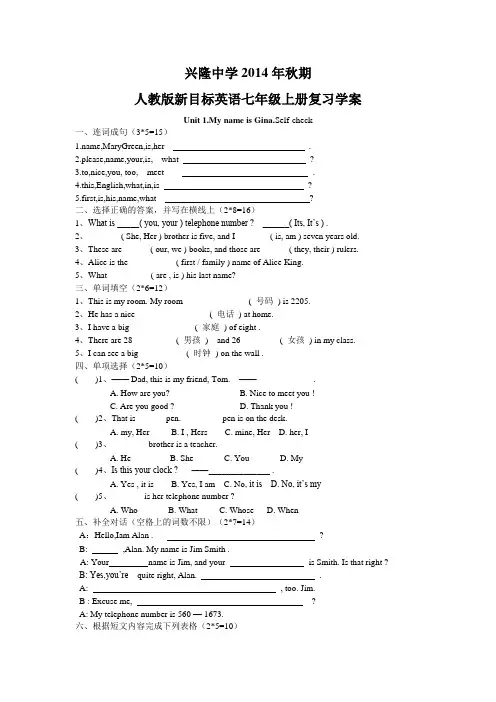
兴隆中学2014年秋期人教版新目标英语七年级上册复习学案Unit 1.My name is Gina.Self-check一、连词成句(3*5=15),MaryGreen,is,her .2.please,name,your,is, what ?3.to,nice,you, too, meet .4.this,English,what,in,is ?5.first,is,his,name,what ?二、选择正确的答案,并写在横线上(2*8=16)1、What is _____( you, your ) telephone number ? ______( Its, It’s ) .2、_______ ( She, Her ) brother is five, and I _______ ( is, am ) seven years old.3、These are ______( our, we ) books, and those are ______( they, their ) rulers.4、Alice is the __________ ( first / family ) name of Alice King.5、What _________ ( are , is ) his last name?三、单词填空(2*6=12)1、This is my room. My room ______________ ( 号码) is 2205.2、He has a nice ________________ ( 电话) at home.3、I have a big ______________ ( 家庭) of eight .4、There are 28 _________ ( 男孩) and 26 ________ ( 女孩) in my class.5、I can see a big __________ ( 时钟) on the wall .四、单项选择(2*5=10)( )1、—— Dad, this is my friend, Tom. —— ____________ .A. How are you?B. Nice to meet you !C. Are you good ?D. Thank you !( )2、That is ______ pen. _______ pen is on the desk.A. my, HerB. I , HersC. mine, HerD. her, I( )3、________ brother is a teacher.A. HeB. SheC. YouD. My( )4、Is this your clock ? ――______________ .A. Yes , it isB. Yes, I amC. No, it isD. No, it’s my( )5、_______ is her telephone number ?A. WhoB. WhatC. WhoseD. When五、补全对话(空格上的词数不限)(2*7=14)A:Hello,Iam Alan . ?B: ,Alan. My name is Jim Smith .A: Your name is Jim, and your is Smith. Is that right ? B: Yes,you’re quite right, Alan. .A: , too. Jim.B : Excuse me, ?A: My telephone number is 560 — 1673.六、根据短文内容完成下列表格(2*5=10)2Hello, my name is Jim Moore. Nice to meet you. Jim is my first name. Moore is my family name. My telephone number is 656- 2368. I am a student. I study in No. 1 Middle School. The七、完成句子(横线上的词数不限)(2*6=12)1.下午好!很高兴认识你(们)。
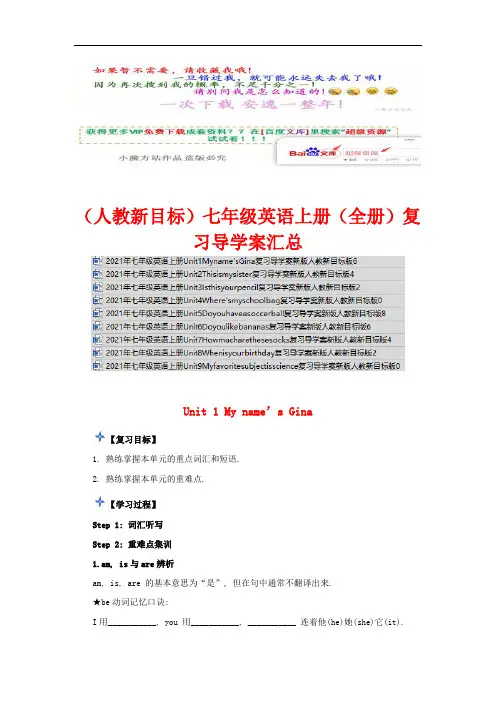
(人教新目标)七年级英语上册(全册)复习导学案汇总Unit 1 My name’s Gina【复习目标】1. 熟练掌握本单元的重点词汇和短语.2. 熟练掌握本单元的重难点.【学习过程】Step 1: 词汇听写Step 2: 重难点集训1.am, is与are辨析am, is, are 的基本意思为“是”, 但在句中通常不翻译出来.★be动词记忆口诀:I用___________, you 用___________, ___________ 连着他(he)她(she)它(it).单数名词用___________, 复数名词用___________.变疑问, ___________, 句末问号莫丢弃;变否定, 更容易, be 后___________莫忘记;疑问否定任你变, 句首大写莫迟疑.★be动词与人称代词或疑问词构成的缩略形式:I am = ___________ he is = ___________ she is = ___________it is =___________ we are =___________ you are =___________they are =___________ what is = ___________where is = ___________【注意】this和is一般不缩写.Ⅰ.用be动词的适当形式填空.1.—How _________ you?—I _________fine.2.—What _________ that in English?—It _________ a pen.3.She and I _________ in China.4.—Who _________ Mr.Webb?—He _________ Jane's father.Ⅱ.按要求完成下列句子5.I'm Mary Miller.(改为一般疑问句)__________________ Mary Miller?6.His first name is Tom.(改为缩略形式)His first _________Tom.7.Is she Linda?(作否定回答)__________________8.I'm Jim Green.(改为同义句)_________________________2.no与not辨析★no可作副词, 用于否定的回答或陈述; 也可作形容词, 直接用于名词前. 如: —Is he John?他是约翰吗?—No, he is Jack.不, 他是杰克.He has no books.他一本书也没有.★not只能用作副词, 用于be动词、助动词或情态动词后, 构成否定形式. 如: S he is not a student.她不是一名学生.3.good, fine与nice辨析good, nice, fine 都含有“好”的意思, 但用法存在区别:★go od主要指“人的品质好”或“东西的质量好”等.★nice着重强调人们的感觉, 含有“漂亮的”“美妙的”“美味的”等意思.★fine侧重于表示“质量精细”或“身体健康”, 也可以表示“天气晴朗”等.Ⅰ.单项选择.( )12.________ afternoon, Ms.Gree n.A.Fine B.Nice C.Good D.Than ks( )13.—How are you?—I'm ________.Thank you.A.good B.yes C.nice D.fineⅡ.根据汉语意思完成句子.14.他是我的好朋友.——————————————————————————15.见到你很高兴.————————————————————————————4.a, an与the辨析★a, an都是不定冠词, 只用在单数可数名词前, 表示一(人、事、物). ___________用在以辅音音素开头的名词前面; ___________用在以元音音素开头的名词前面.如: ___________一支铅笔; ___________一位老人.★the为定冠词, 用法口诀如下:特指双方熟悉, 上文已经提及; 世上独一无二, 方位名词乐器;某些专有名词, 外加复数姓氏; 序数词最高级, 习惯用语要特记.用a, an或the填空, 不需要填冠词的填“/”.16.—Is this ___________ cup?—Yes, it is. ___________ cup is white.17.—What's his ___________ first name?—Jack.And his ___________ last name is Green.18.—What's that in___________ English?—It's ___________telephone.19.Her friend works(工作) in ___________ middle school.St ep 3: 实战演练1.在线检测: 请你在平台完成Unit 1 My name`s Gina单元检测), 提交后自己看错题及解析.Unit 2 This is my sister【复习目标】1. 熟练掌握本单元的重点词汇和短语.2. 熟练掌握本单元的重难点.【学习过程】Step 1: 词汇听写Step 2: 重难点集训1.of的用法★of意为“……的”, 常用来表示所属关系. 表示无生命物体的所属关系常用“所有物+of+所属物”的形式. 如:a map of the world一张世界地图desks and chairs of our school我们学校的桌椅学以致用Ⅰ.按要求完成下列句子1.It's her family photo.(改为同义句)It's a ________________her family.2.this, a, photo, his, school, is, of(连词成句)________________________________Ⅱ.根据汉语意思完成句子, 每空一词.3.那是一张中国地图.That is ________________.4.这条狗的名字是蔻蔻.The ________________ is Coco.2.here倒装句的用法★在英语中以here开头的句子常用倒装句式, 其结构为“Here+is/are+主语(名词或名词短语)”. 当主语是可数名词单数或不可数名词时, 动词用is; 当主语是可数名词复数时, 动词用are. 如:Here i s a pencil.这里有一支铅笔.Here are some apples for you.这里有一些苹果给你.【拓展】here引导的倒装句中, 代词充当句子的主语, 常用部分倒装. 即“Here+代词+is/are”. 如:Here you are.给你.学以致用Ⅰ.单项选择.( )5.—________your pictures.They're very nice.—Thanks.A.Here is B.Here are C.He is D.She is( )6.Here________a pen for your sister.A.am B.is C.are D.aren'tⅡ.根据汉语意思完成句子.7.这里有四幅图画.________________ four ______________.8.这里有一件紫色的夹克衫.________________ a purple jacket.9.这里有三个橙子.________________ three ____________.3.who的用法★who为疑问代词, 意为“谁”, 用来询问人物关系或身份等. 回答时, 若主语为单数, 根据人物的性别选用代词he或she; 若主语为复数, 应用代词they. 常用结构为“Who +be动词+某人?”, 其回答为He is…/She is…/They are…学以致用Ⅰ.单项选择.( )10.—________is that girl?—She's my friend, Jenny.A.How B.What C.Where D.Who( )11.—Who are they?—________.A.They are my friendsB.She is my friendC.Those a re my friendsD.Those are my friendⅡ.对句中画线部分提问.12.The man is Tom's__uncle.________________ the man?13.These two girls are my__cousins.________________ these two girls?4.this, that, these与those辨析★these意为“这些”, 表示复数意义, 指较近的物体, 其单数形式为this(这; 这个).★those意为“那些”, 表示复数意义, 指较远的物体, 其单数形式为that(那; 那个).学以致用Ⅰ.单项选择.( )14.—Are these your friends?—Yes, ________ are.A.this B.that C.these D.they( )15.________ dogs are yellow.________ are my dogs.A.Those; They B.They; ThoseC.That; Those D.This; TheyⅡ.用this, that, these, those填空.16.—Are ________________your books?—No. My books are over there.17.—Are________________ your pictures on the desk over th ere?—Yes, they are.18.—Hello. __________ is Jane. Is ______________Bob?—Yes, speaking.Step 3: 实战演练1.在线检测: 请你在平台完成Unit 2 This is my sister.单元检测), 提交后自己看错题及解析.参考答案重难点集训学以致用Ⅰ.1.photo of2.This is a photo of his school.Ⅱ. 3.a map of China.4.name of the dog2.here倒装句的用法学以致用Ⅰ.BBⅡ.7. Here are , pictures.8.Here is9.Here are oranges.3.who的用法学以致用Ⅰ.DAⅡ. 12.Who is13.Who are4.this, that, these与those辨析学以致用Ⅰ.DAⅡ. 16. these_17. those18. This , thatUnit 3 Is this your pencil 【复习目标】1. 熟练掌握本单元的重点词汇和短语.2. 熟练掌握本单元的重难点.【学习过程】Step 1: 词汇听写Step 2: 重难点集训1.some的用法★some作形容词时, 可以修饰复数可数名词, 也可以修饰不可数名词. 如:There are some students in the classroom.教室里有一些学生.There is some milk in the glass.杯子里有一些牛奶.★some作代词时, 可单独使用, 也可接o f, 作主语时谓语动词的单复数形式由其后的名词决定. 如:Some of the money is mine.有一些钱是我的.学以致用Ⅰ.单项选择.( )1.Some ________ are in the pencil box.A.computers B.pen C.picture D.erasers( )2.An orange and ________ cards are in the box.A.a B.some C.one D.an( )3.________ in the school library.A.A teacher are B.A teachers areC.Some teachers is D.Some teachers areⅡ.根据汉语意思完成句子, 每空一词.4.我们在那幅图画中能看见一些手表.We can see _______ _________ in the picture.5.我有一些蓝色的盒子.I have ______ blue _______.2. must的用法★must是情态动词, 意为“必须”, 无时态和人称的变化, 后接动词原形, 表示义务或命令. 如:You must find your lost pen.你必须找到你丢失的钢笔.学以致用Ⅰ.单项选择.( )6.My English book is lost. I ________ find it.A.am B.do C.can D.mustⅡ.根据汉语意思完成句子, 每空一词.7.我们必须帮助他.We _______ _______ _______.8.我必须用英语说吗?_______ I _______ it in English?3.thank的用法thank作动词, 意为“感谢; 谢谢”, 常用结构:★thank (sb.)for (doing) sth., 表示“感谢(某人)做了某事”. 如:Thank you for your letter.谢谢你的来信.★Thank you和Thanks常单独使用, 作为表达谢意的礼貌用语. 其常见答语: You are welcome./That's all right./That's OK./Don't mention it./It's a plea sure.学以致用单项选择.( )9.Thank you ________ your computer.A.of B.to C.for D.at( )10.—Your pencil box is nice.—________.A.Yes B.No C.Thank you D.It isn't nice( )11.—Thank you.—________.A.You, too B.Excuse meC.Nice to meet you D.You're welcome( )12.—Have a good day!—________.A.OK B.Thank youC.Good morning D.I'm fine4.What about…?的用法★Wha t about…?意为“……怎么样?……好吗?”, about为介词, 其后可接名词、代词或动词-ing形式, 常用于询问或打听消息, 向对方提出建议, 征询对方的看法或建议, 与how about可互换使用. 如:What about your uncle now?你的叔叔近来好吗?What about a cup of tea?喝一杯茶怎么样?What about the TV play?那个电视剧怎么样?I am from Beijing.What about you?我来自北京, 你呢?学以致用Ⅰ.单项选择.( )13.—________ the black jacket?—It's nice.A.What B.How C.Who D.What about( )14.—I'm fine.________?—I'm fine, too.A.Are you Alan B.Is this your bookC.What about you D.Who are you( )15.What about ________ swimming?A.go B.goes C.going D.to goⅡ.同义句转换, 每空一词.16.My schoolbag is blue. Is your schoolbag blue, too?My schoolbag is blue. _______ _______ yours?17.This pen is Eric's. How about that pencil?This pen is Eric's. _______ _______ that pencil?Step 3: 实战演练1.在线检测: 请你在平台完成Uni t 3 Is this your pencil?单元检测, 提交后自己看错题及解析.参考答案重难点集训1.some的用法学以致用Ⅰ.DBDⅡ. some watches5.some boxes.2. must的用法学以致用Ⅰ.DⅡ. 7.must help him.8. Must say3.thank的用法学以致用CCDB4.What about…?的用法学以致用Ⅰ.DCCⅡ. 16.What/How about17.What aboutUnit 4 Where’s my schoolbag【复习目标】1. 熟练掌握本单元的重点词汇和短语.2. 熟练掌握本单元的重难点.【学习过程】Step 1: 词汇听写Step 2: 重难点集训1.where的用法★where是疑问副词, 意为“在哪里; 到哪里”, 常用来引导特殊疑问句, 用于询问某人或某物的位置. 基本结构: Where+be动词+限定词+名词?其中be动词的单复数形式取决于其后的名词. 如:—Where is your mom?你的妈妈在哪里?—She is in the garden.她在花园里.—Where are those pencils?那些铅笔在哪里?—They are in the pencil box.它们在铅笔盒里.学以致用Ⅰ.单项选择.( )1.—________ is my sister, Mom?—In her room.A.Who B.What C.Where D.How( )2.—Where ________ your CDs?—On the TV.A.is B.are C.be D.am( )3.—________ my tape player?—On the table.A.Where B.Where is C.Where are D.How is( )4.—Where is that radio?—________ under the chair.A.This is B.That is C.It is D.They are( )5.—________?—They're on the sofa.A.Where are my books B.Where is my bookC.Where's my books D.Where my books areⅡ.根据汉语意思完成句子, 每空一词.6.——他的书包在哪里?——在课桌下面.—__________ his schoolbag?—It's __________ the desk.7.——你的父母在哪里?——他们在客厅里.—__________ __________ your parents?—They're in the living room.2.ask的用法★ask作动词, 意为“询问”, 对应词为answer, 意为“回答”. 如: Can I ask you a question?我能问你一个问题吗?★ask作动词, 意为“要求; 请求”, 常用结构:ask sb.for sth.问某人要某物ask sb.for help.向某人寻求帮助ask sb.to do sth.要求某人做某事学以致用单项选择.( )8.You can ask the teacher ________ your computer game.A.to B.for C.in D.at( )9.Our teacher asks us ________ hard.A.study B.to study C.is D.to be3.and与but辨析★and意为“和; 又; 而”, 常位于句中, 用来连接并列的成分, 表示并列或顺承关系. 如:There is a pen and a book on the desk.桌子上有一支钢笔和一本书.★but意为“但是”, 用来连接并列的成分, 表示语义上的转折. 如:I like blue, but my sister likes pink.我喜欢蓝色, 但是我的姐姐喜欢粉色.学以致用Ⅰ.单项选择.( )10.I am looking for(寻找) my pen everywhere, ________ I can't find it.A.but B.and C.too D.for( )11.My sister________ I are tidy, ________my brother isn't.A.and; and B.but; but C.and; but D.but; andⅡ.用and或but完成下列句子.12.I have a new watch, __________ I don't like it.13.These are my parents, __________ those are my friends.4.in与on辨析★in意为“在……里”, 常指某人/物在某范围空间里.★on意为“在……上”, 强调某物在另一物体的表面上.【拓展】in the tree 与on the tree都表示“在树上”, in the tree指外来的附在树上的事物; on the tree指树本身自然生长出来的事物.学以致用Ⅰ.用适当的方位介词填空.14.Look!There is a little cat __________the tree.15.—Where are Jim and his father?—They're __________ the sofa.Ⅱ.根据汉语意思完成句子16.那面墙上有一些画.There are some pictures __________ .17.钥匙在沙发上面.The keys __________ the sofa.18.地图在书包里.The map __________ the schoolbag.Step 3: 实战演练1.在线检测: 请你在平台完成Unit 4 Where’s my schoolbag?单元检测, 提交后自己看错题及解析.参考答案重难点集训where的用法学以致用Ⅰ.CBBCAⅡ.—Where's ,under7.—Where areask的用法学以致用BBand与but辨析学以致用Ⅰ.ACⅡ.12. but 13. andin与on辨析学以致用Ⅰ. 14.in15.onⅡ.16. on the wall.17.are on18.is inUnit 5 Do you have a soccer ball【复习目标】1. 熟练掌握本单元的重点词汇和短语.2. 熟练掌握本单元的重难点.【学习过程】Step 1: 词汇听写Step 2: 重难点集训1.let的用法★let作动词, 常用于let sb./sth.do sth.结构, 表示“让某人/某物做某事”.★let's 是let us 的缩写形式, us意为“我们”, 是we的宾格, 放在动词let后作宾语. let's开头的祈使句结构为“Let's do sth.”, 意为“(让)我们做某事吧”, 表示说话人的建议或请求. 肯定回答一般用“OK.”, “All right.”等, 否定回答一般用“Sorry, I…”等. 如:—Let's play basketball!让我们打篮球吧!—OK.好的.学以致用Ⅰ.单项选择.( )1.—I can't spell it.—Let me ________ you.A.helping B.helps C.to help D.help( )2.—Let's ________ volleyball now.—That sounds good.A.plays B.play C.playing D.to play( )3.Let ________ play computer games.A.they B.their C.them D.theirs( )4.—Let's play ping-pong.—________ Let's go.A.Great! B.That's boring.C.I have a volleyball. D.I don't like ping-pong.Ⅱ.用括号内所给单词的适当形式填空.5.Let _______(I) get the jacket for you.6.Let's_______ (go) to the library now.2. play的用法★play意为“参加(比赛或运动)”, 其后常接球类、棋牌类名词作宾语.【注意】play与球类或棋牌类名词连用时, 球类或棋牌类名词前不加任何冠词.学以致用Ⅰ.单项选择.( )7.—It's a fine day.Let's play________basketball.—OK.A.a B.an C.the D./( )8.Peter can play________soccer, but he can't play________piano.A.the; the B.the; / C./; the D./; aⅡ.根据汉语意思完成句子, 每空一词.9.李娜打网球而不打排球.Li Na_______ _______ but she doesn't_______ _______.10.下课后我们做运动吧!Let's_______ _______ after class.3. sound的用法★sound在句中作连系动词, 意为“听起来”, 其后接形容词作表语. “That+soun ds +形容词”意为“那听起来……”. 这一句型常用于口语中, 用于表示对某事的看法或态度. 学以致用Ⅰ.单项选择.( )11.—Do you like Li Qi?—Yes.His new CD________good.A.sound B.sounds C.look D.looksⅡ.用括号内所给单词的适当形式填空.12.—Let's watch TV.—That_______ (sound) boring.13.—I like to watch TV.—That sounds_______ (relax).4.have与there be辨析★have表示“有”, 强调所属关系, 在句中作谓语时, 主语位于have之前, 当主语是第三人称单数时, have要变成has.★there be句型表示“(某地)有某人或某物”, 强调存在, there be句型中主语位于be动词之后, 且be动词要与最近的主语在人称和数上保持一致.学以致用Ⅰ.单项选择.( )14.—Does he ________ a soccer ball?—Yes, he does.He ________ four.A.have; have B.have; has C.has; have D.has; has( )15.I ________ a baseball and my friend ________ a volleyball.A.has; has B.have; have C.have; has D.has; have( )16.—________ you ________ a picture of the school?—Yes.A.Do; have B.Do; has C.Does; have D.Does; hasⅡ.用have或there be的适当形式填空.17.He_______ a nice watch.18. _______ a book and three pens on the desk.19.What does Mike_______?Step 3: 实战演练1.在线检测: 请你在平台完成Unit 5 Do you have a soccer ball?单元检测, 提交后自己看错题及解析.参考答案重难点集训1.let的用法学以致用Ⅰ.DBCAⅡ.5.me 6. go2. play的用法学以致用Ⅰ.DCⅡ. 9. plays tennis, play volleyball.10.play sports3. sound的用法学以致用Ⅰ.BⅡ. 12.sounds13.relaxing4.have与there be辨析学以致用Ⅰ.BCAⅡ.17. has 18. There__is19. haveUnit 6 Do you like bananas?【复习目标】1. 熟练掌握本单元的重点词汇和短语.2. 熟练掌握本单元的重难点.【学习过程】Step 1: 词汇听写Step 2: 重难点集训1.well与good辨析★well用作副词, 常置于动词之后, 表示程度“好; 满意地”; 也可用作形容词, 指“身体好”. 如:The boy can swim very well.这个男孩游泳游得很好.★good是形容词, 常置于名词之前作定语, 指人的品质或物品的质量好, 也可用于系动词后作表语. 如:Mr.Wang is a good teacher.王老师是一位好老师.学以致用Ⅰ.单项选择.( )1.—Do they eat ________ at school every day?—Yes, they do.A.good B.nice C.fine D.well( )2.—Your English is________.—Thank you.A.good B.well C.bad D.OK( )3.Susan is a ________ student and she does ________ at school.A.well; good B.good; good C.well; well D.good; wel lⅡ.用good或well填空.4.—Does h is friend play football_________?—No, he doesn't.5.—Let's play volleyball after class.—That sounds _________.6.—Is this a_________ book?—Yes, it is.7.—How is your father?—He is _________.Thank you.2.chicken的用法★chicken作名词, 意为“鸡肉”, 此时为不可数名词; 意为“小鸡”时, 是可数名词, 复数形式为chickens.【拓展】与chicken类似的词有orange, 表示“橙汁”时为不可数名词, 表示“橙子”时为可数名词, 其复数形式为oranges.学以致用单项选择.( )8.My grandmother has many ________, because I like eating ________. A.chicken; chickens B.chickens; chickenC.chickens; chickens D.chicken; chicke n( )9.I'm thirsty.I would like to drink some ________.A.orange B.an orangeC.oranges D.a bottle of orange3.want的用法★want为动词, 意为“需要; 想要”, 常用结构:want sth.想要某物want to do sth.想要做某事want sb.to do sth.想要某人做某事学以致用Ⅰ.单项选择.( )10.My schoolbag is old(旧的).I ________ a new(新的) one.A.meet B.want C.do D.play( )11.Tom wants ________ basketball with us.A.play B.to play C.plays D.pla ying( )12.S he wants ________ to get some apples for her.A.them B.they C.their D.theirsⅡ.将下列句子翻译成英语.13.我想要一本词典._________14.午饭她想吃汉堡包._________15.凯特想要我帮助她._________4.have, eat, take与drink辨析★have既可以指“吃”, 也可以指“喝”. 当与meal以及表示三餐的名词连用时, 多用have. 如: have breakfast吃早餐, have dinner吃正餐, have a meal吃一顿饭.★eat多用来表示“吃”. 如: eat an apple吃苹果.★take作“吃”、“喝”讲时比较少见, 主要用于“服药”, 如: take medicine服药.★drink习惯上用于喝水、茶、奶、咖啡等饮料, 一般不作“吃”讲. 如: drink some juice喝一些果汁.Step 3: 实战演练1.在线检测: 请你在平台完成Unit 6 Do you like bananas?单元检测, 提交后自己看错题及解析.参考答案重难点集训1.well与good辨析学以致用Ⅰ.DADⅡ.4. well?5.good.6. good7.well2.chicken的用法学以致用BA3.want的用法学以致用Ⅰ.BBAⅡ.将下列句子翻译成英语.13.I__want__a__dictionary.14.She__wants__to__eat__hamburgers/burgers__for__lunch.15. Kate__wants__me__to__help__her.Unit 7 How much are these socks【复习目标】1. 熟练掌握本单元的重点词汇和短语.2. 熟练掌握本单元的重难点.【学习过程】Step 1: 词汇听写Step 2: 重难点集训1.how much与how many辨析★how much用来询问物体的价格时, 后面既可接复数可数名词, 又可接不可数名词; 常用结构: How much+be+名词?=What's the price of+名词. 当how much用来询问数量时, 后面只接不可数名词. 如:How much are these shorts?这些短裤多少钱?How much water do you drink every day?你每天喝多少水?★how many用来询问可数名词的数量, 后接可数名词的复数形式.学以致用Ⅰ.单项选择.( )1.—________ are the black trousers?—They are 15 dollars.A.Where B.How C.What color D.How much( )2.—________ books do you have?—150.A.How many B.How much C.How old D.How much moneyⅡ.用many或much 填空.3.How______is that skirt?4.How______people are there in your family?5.How _______rice do you need?6.How _______bread is there in the box?2. pair的用法★pair为可数名词, 常用于“数词+pair(s)+of”结构, 当数词大于1时, pair要用复数形式, 该结构后接“成对出现”的名词, 如shoes(鞋), gloves(手套), glasses(眼镜), trousers(裤子), socks(短袜), scissors(剪刀)等.学以致用Ⅰ.单项选择.( )7.This pair of trousers ________ 35 dollars.A.does B.do C.is D.ar e( )8.—What do they want to buy?—________.A.Three pair of sockB.Three pairs of sockC.Three pair of socksD.Three pairs of socksⅡ.根据汉语意思完成句子, 每空一词.9.他想要一双蓝色的鞋.He wants______ ______ ______ blue shoes.10.这条白色的短裤多少钱?How m uch ______ this______ ______ white shorts?11.这些袜子价格合理.These______ ______ ______ ______ at very good prices.3.buy, sell与sale辨析★buy作动词, 意为“购买”, 后常接名词或代词做宾语. 常用结构: buy sb.sth.=buy sth.for sb.给某人买某物.★sell作动词, 意为“出售”, 常用结构: sell sth. to…把某物卖给……; sell sth.for+价格, 以……价格出售; sell out卖完.★sale作名词, 意为“出售”, 常用结构: for sale待售; on sale特价出售.学以致用单项选择.( )12.—Shall we go to the bookstore?—All right!I hear there are many good books ________.We can ________ some.A.for sale; sell B.on sale; buy C.in sale; sell D.on sale; sell( )13.We can ________ books ________ the bookstore.A.sell; on B.bu y; from C.sell; from D.buy; to4. look, see与watch辨析★look指集中注意力地“看”, 强调“看”的动作. 单独使用时, 用来引起对方的注意. 如:Look!Tom is over there.看!汤姆在那儿.★see强调“看”的结果, 意为“看见; 看到”. 如:How many birds can you see in the tree?你能看到树上有多少只鸟儿?★watch强调“专注地看”, 有欣赏的意味, 常用于看电视、球赛等. 如:Do you watch TV at night?你晚上看电视吗?学以致用Ⅰ.单项选择.( )14.—Does Tom's grandf ather ________ TV in the evening?—Yes, he does.A.look B.see C.watch D.play( )15.Boys and girls, please ________ at the picture.A.watch B.look C.see D.needⅡ.用look, watch或see的适当形式填空.16.—Does your brother want______ the soccer game on TV?—No, he doesn't.17.Do these photos______very nice?18. ______!That boy is my classmate.19.—What can you ______in the picture?—A desk and two ch airs.Step 3: 实战演练1.在线检测: 请你在平台完成Unit 7 How much are these socks?单元检测, 提交后自己看错题及解析.参考答案重难点集训1.how m uch与how many辨析学以致用Ⅰ.DAⅡ.3. much4. many5. much_6. much_2. pair的用法学以致用Ⅰ.CDⅡ.9. a pai r of10.is ,pair of11.pairs of socks are3.buy, sell与sale辨析学以致用BB4. look, see与watch辨析学以致用Ⅰ.CBⅡ.用look, watch或see的适当形式填空.16.to_watch17. look18. Look19.seeUnit 8 When is your birthday 【复习目标】1. 熟练掌握本单元的重点词汇和短语.2. 熟练掌握本单元的重难点.【学习过程】Step 1: 词汇听写Step 2: 重难点集训1.happy的用法★happy为形容词, 意为“愉快的; 高兴的”, 在句中既可作定语, 又可作表语. 常用结构: be happy to do sth.很高兴做某事; be happy for sb.为某人感到高兴.【拓展】名词形式为happiness, 反义词为unhappy.学以致用Ⅰ.单项选择.( )1.—It's nice to meet you here, Dale.—I'm ________ to see you, too.A.late B.happy C.first D.easy( )2.—________ birthday to you, Eric!—Thank you.A.Nice B.Good C.Well D.HappyⅡ.根据汉语意思完成句子, 每空一词.3.你的朋友有一个幸福的家庭吗?________ your friend________ ________ ________ family?4.我很高兴帮助你.I'm very________ ________ ________ you.2.when的用法★when为疑问副词, 意为“什么时候”, 常用来引导特殊疑问句, 基本结构为“When +一般疑问句?”, 用来对时间进行提问. 回答时常用介词at, in或on等组成的表示时间的介词短语.学以致用Ⅰ.单项选择.( )5.—________do you have a book sale?—It's on December 3rd.A.How B.What C.When D.Who( )6.—When is your cousin's birthday?—________ on June 2nd.A.You're B.She's C.We're D.It'sⅡ.对句中画线部分提问, 每空一词.7.They want to come here on__December__24th.________ ________ they want to come here?8.The English test is on__November__29th.________ ________ the English test?3.how old的用法★how old意为“多大年纪”, 常用句型“How old+be动词+主语?”相当于“What +be动词+one's age?”. 回答时用“主语+be动词+基数词(+years/mont hs old)”.学以致用Ⅰ.单项选择.( )9.—________is your daughter?—She's ten months old.A.How old B.How C.What D.Where( )10.—________?—I'm sixteen.A.How many years are you B.How are youC.How old are you D.How much are youⅡ.按要求完成下列句子, 每空一词.11.Miss Jones is twenty-five__years__old.(对画线部分提问)________ ________ is Miss Jones?12.What's your sister's age?(改为同义句)________ ________ ________ your sister?4.on, in与at辨析★on表示具体的某一天. 如: on July 10th, 2017表示2017年7月10日.★in表示一天中的上午/下午/晚上或某年/月. 如: in the morning在早上; in May 在五月.★at表示具体到某一时刻. 如: at five 在五点钟.学以致用Ⅰ.单项选择.( )13.—When is your School Day?—It's ________ March 14th.A.in B.on C.at D.to( )14.My mother's birthday is ________ September.A.on B.at C.in D.for( )15.His sis ter always comes here ________ eight ________ the morning.A.on; at B.in; at C.at; in D.at; onⅡ.根据句意, 用in, on或at填空.16.Let's meet________ 9: 30 next Monday morning.17.Our School Day is ________ November 25th.18.What activities do you have________ October?19.I was born________ a cold(寒冷的) morning in May.Step 3: 实战演练1.在线检测: 请你在平台完成Unit 8 When is your birthday?单元检测, 提交后自己看错题及解析.参考答案1.happy的用法学以致用Ⅰ.BD.Ⅱ. 3. Does , have a happy4. happy to help2.when的用法学以致用Ⅰ.CDⅡ.7. When do8. When is3.how old的用法学以致用Ⅰ.ACⅡ.11.How old12.How old is4.on, in与at辨析学以致用Ⅰ.BCCⅡ.16. at 17. on 18. in 19. onUnit 9 My favorite subject is science.【复习目标】1. 熟练掌握本单元的重点词汇和短语.2. 熟练掌握本单元的重难点.【学习过程】Step 1: 词汇听写Step 2: 重难点集训eful的用法★useful作形容词, 意为“有用的; 有益的”, 在句中既可作定语, 又可作表语. 常用结构: be useful for/to…对……有用.学以致用单项选择.( )1.I think it is ________ useful book.A.an B.a C.the D./( )2.—Why do you like English?—Beca use I think it is very ________.A.useful B.difficult C.tidy D.boring( )3.The dictionary is ________ for my daughter.I want to buy it.A.cool B.interesting C.useful D.free2.finish的用法★finish意为“结束; 完成”, 用作及物动词时后接名词、代词或动词-ing形式. 如:Finish your homework this afternoon.今天下午完成你的作业.Finish it on time, please.请按时完成它.Can you finish read ing the book in a week?一周内你能读完这本书吗?学以致用Ⅰ.单项选择.( )4.Our last class________at 4: 30 in the afternoon.A.has B.have C.finish D.finishes( )5.—Can I go out to play football, Mom?—When you________your homework, you can go out.A.take B.finish C.help D.call( )6.—When will you finish________computer games?—At 9: 30.A.playing B.plays C.play D.to playⅡ.用括号内所给单词的适当形式填空.7.The meeting __________(finish) at 11: 50 in the morni ng.8.She plays sports after she finishes __________ (eat) dinner.3.because, but与so辨析★because意为“因为”, 表示原因, 常用于回答why引导的特殊疑问句; 也可用于连接两个具有因果关系的句子.★but意为“但是”, 表示转折关系.★so意为“因此”, 表示因果关系.学以致用Ⅰ.单项选择.( )9.Jenny likes Tuesday________her favorite subject is on Tuesday.A.after B.but C.so D.because( )10.—Would you like to go to the concert with me tonight?—I'd love to, ________ I can't.I have a lot of homework to do.A.because B.and C.but D.s oⅡ.对句中画线部分提问, 每空一词.11.Liu M in is very happybecause_she_will_go_to_Beijing_with_her_family_next_week.__________ __________ Liu Min very happy?4.relaxing与relaxed辨析★relaxing 意为“令人放松的”, 一般修饰物. 如:Music is relaxing.音乐是令人放松的.★relaxed意为“感到放松的”, 一般修饰人. 如:I am very relaxed on weekends.我周末感到非常放松.【拓展】类似用法的词还有interesting与interested; boring与bored; surprising 与surprised等.学以致用单项选择.( )12.People are really ________ on the beach in summer(夏季).A.relaxed B.relaxing C.relax D.to relax( )13.Watching movies makes me ________.A.relaxing B.relaxed C.to relax D.relaxes( )14.—What kind of books do you like?—I like storybooks. They're very ________.A.boring B.bore d C.interest ed D.interestingStep 3: 实战演练1.在线检测: 请你在平台完成Unit 9 My favourite subject is science.单元检测, 提交后自己看错题及解析.参考答案重难点集训eful的用法学以致用BAC2.finish的用法学以致用Ⅰ.DBAⅡ. 7 .finishes 8. eating3.学以致用Ⅰ.DCⅡ.11.Why is4.relaxing与relaxed辨析学以致用ABD1在一次踏青活动中,我认识了彩虹,一个皮肤很白的小美女。
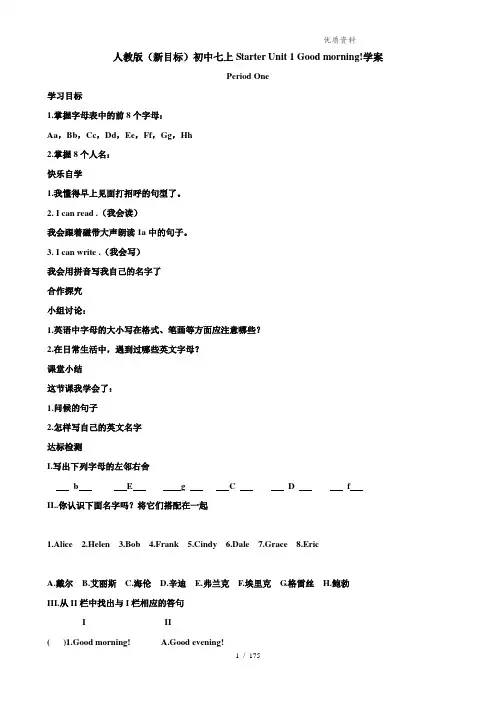
人教版(新目标)初中七上Starter Unit 1 Good morning!学案Period One学习目标1.掌握字母表中的前8个字母:Aa,Bb,Cc,Dd,Ee,Ff,Gg,Hh2.掌握8个人名:快乐自学1.我懂得早上见面打招呼的句型了。
2. I can read .(我会读)我会跟着磁带大声朗读1a中的句子。
3. I can write .(我会写)我会用拼音写我自己的名字了合作探究小组讨论:1.英语中字母的大小写在格式、笔画等方面应注意哪些?2.在日常生活中,遇到过哪些英文字母?课堂小结这节课我学会了:1.问候的句子2.怎样写自己的英文名字达标检测I.写出下列字母的左邻右舍b E g C D fII..你认识下面名字吗?将它们搭配在一起1.Alice2.Helen3.Bob4.Frank5.Cindy6.Dale7.Grace8.EricA.戴尔B.艾丽斯C.海伦D.辛迪E.弗兰克F.埃里克G.格雷丝H.鲍勃III.从II栏中找出与I栏相应的答句I II( )1.Good morning! A.Good evening!( )2.Hi, Ann! B.Good morning!( )3.Good afternoon! C.Hi, Tom!( )4.Good evening! D.Good afternoon!IV.补全对话1.-________________, Helen!-Good morning, Cindy!2.-Hi, Bob.-________________, Alice.3.-Good evening!-_______________!V.单项选择( )1.早上或上午见面说:“_______”A.Good morning!B.Good afternoon!C.Good evening! ( )2.熟人之间打招呼时应说:“_______”A.Hi!B.Good morning!C.Good afternoon!( )3.傍晚遇见你的好朋友说:“_______”A.Good morning!B.Hi!C.Good evening!( )4.当别人对你说Hello, Frank!你应说:“_______”A.Hello, Eric!B.Good morning, Eric!C.Good evening, Eric! 学习反思答案:I.a b c D E F f g h B C D C D E e f g II.1-8. BCHEDAGFIII.1-4.BCDAIV.1. Good morning2.Hello/Hi3. Good eveningV.1-4.AACA人教版(新目标)初中七上Starter Unit 1 Good morning!学案Period Two学习目标1.掌握字母表中的前8个字母:Aa ,Bb ,Cc ,Dd ,Ee ,Ff ,Gg ,Hh2.掌握3个新单词:HB ,CD ,BBC快乐自学1. I can listen .(我会听)我会听录音并跟读2a2. I can finish .(我会完成)我能根据2b 听录音,根据所听到的顺序为字母编号。
七年级上册复习教案Unit 1 My name’s Gina.一、Numberszero one two three four five six seven eight nine ten二、Telephone numbersEnglish name:first name +(middle name)+ family name eg. Jim Brown First name (given name) & Family name (last name)三、Expressions自我介绍(Introduce yourself)My name is Tony .OR:I’m Tony .Tony .询问对方/他人姓名:1.–What’s your name?--My name is …/ I am …2. –What’s his/her name?--His/Her name is…3. –What’s your family name/first name?--My family name/first name is…4. –What’s his/he r family name/first name?--His/her family name/ first name is…问候他人(Greet people)--Nice to meet you.--Nice to meet you.询问和给出电话号码(Ask for &give telephone number)–What’s your/his/her telephone number?--My/His/Her telephone number is 220-1345.OR: --I t’s+号码.四、Grammar1、be ( is \ am \ are) 动词用法:口诀:I 用am , you 用are , is 用于她他它(she \ he \ it)单数形式用is , 复数形式要用are.Eg. I am a student.You are my teacher.She is a girl. He is a boy. It is a penWhat is your name?My phone number is 220-1234.2、本单元出现的形容词性物主代词(Pronouns for ownership)my/your/his/her均为形容词性物主代词,其后面必须跟上用于表示“人”或“物”的名词。
七年级英语上册期末复习专项教案人教新目标版一、教学目标1. 知识目标:(1)复习并巩固本学期所学的单词、短语和句型。
(2)回顾和掌握常用的语法知识,如一般现在时、一般过去时和一般将来时。
(3)提高听、说、读、写的综合语言运用能力。
2. 能力目标:(1)能够熟练运用所学单词、短语和句型进行日常交流。
(2)能够正确运用一般现在时、一般过去时和一般将来时描述人或事物的状态和变化。
(3)提高听力理解能力,能够准确理解外籍教师或同学的讲解和提问。
3. 情感目标:(1)培养学生的学习兴趣,激发学生继续学习英语的积极性。
(2)培养学生团队合作精神,提高学生与他人合作学习的意识。
二、教学内容1. 单词复习:回顾本学期所学的重要单词和短语,进行单词接龙游戏等活动。
2. 句型复习:复习常用的句型,如询问姓名、年龄、爱好等,以及回答相应问题的表达方式。
3. 语法复习:回顾和巩固一般现在时、一般过去时和一般将来时的用法,进行相关练习题的讲解和练习。
三、教学过程1. 热身活动(5分钟):进行简单的英语对话,引导学生复习和回顾已学过的知识。
2. 单词复习(10分钟):学生分组进行单词接龙游戏,教师巡回指导并纠正发音错误。
3. 句型复习(10分钟):学生进行角色扮演,运用所学句型进行对话练习,教师给予反馈和指导。
4. 语法复习(10分钟):教师讲解和解释一般现在时、一般过去时和一般将来时的用法,学生进行相关练习题的解答。
5. 综合练习(10分钟):学生完成一份综合练习题,包括听力、阅读和写作部分,教师进行讲解和指导。
四、课后作业1. 复习本节课所学的单词、短语和句型。
2. 完成一份相关的语法练习题。
3. 预习下一节课的内容,准备进行课堂讨论和展示。
五、教学评价1. 课堂参与度:观察学生在课堂上的积极参与情况和合作意识。
2. 发音准确性:评估学生在单词接龙游戏中的发音准确性。
3. 对话流畅性:评价学生在角色扮演中的对话流畅性和语言组织能力。
七年级上册英语复习教案(一)Unit 1 My name’s Gina.一、Numberszero one two three four five six seven eight nine ten二、Telephone numbersEnglish name: first name +(middle name)+ family name eg. Jim Alan Brown First name (given name) & Family name (last name/ surname)三、Expressions自我介绍(Introduce yourself)My name is Tony .OR:I’m Tony .询问对方/他人姓名:1.–What’s your name?--My name is …/ I am …2. –What’s his/her name?--His/Her name is…3. –What’s your family name/first name?--My family name/first name is…4. –Wha t’s his/her family name/first name?--His/her family name/ first name is…问候他人(Greet people)--Nice to meet you.--Nice to meet you.询问和给出电话号码(Ask for &give telephone number)–What’s your/his/her telephone number?--My/His/Her telephone number is 220-1345.OR: --It’s+号码.四、Grammar1、be ( is \ am \ are) 动词用法:口诀:I 用am , you 用are , is 用于她他它(she \ he \ it)单数形式用is , 复数形式要用are.Eg. I am a student.You are my teacher.She is a girl. He is a boy. It is a penWhat is your name?My phone number is 220-1234.2、本单元出现的形容词性物主代词(Pronouns for ownership)my/your/his/her 均为形容词性物主代词,其后面必须跟上用于表示“人”或“物”的名词。
最新英语人教版七年级上总复习学案七年级英语总复习(一)A.英语句型转换(英语的句子类型有:陈述句,包括肯定句和否定句;疑问句, )一、肯定句变否定句 :句子中如有 be (am, is, are),或情态动词 can, must 等,在be 或情态 动词后加not 。
练习:将下列句子变成否定句1.1 am a doctor I ______________ a doctor2. The girs are students. The gi _________ students.3. Jane is a nurse Jane ______ a nurse4. He can play football. H __________ play football.5. We must go now. We _____________________ go now.如果句子中没有 be (am, is ,are)或情态动词,只有行为动词原形,在动词前加don't 。
如果行 为动词是第三人称单数,在动词前加doesn',行为动词恢复原形。
1)」have a book. I _______________________ a book. 2). They like Chinese. TheyChinese.3) . We come from China.We _ 4) .She has a small mouth. She _ 5) .Maria likes China.Maria 6) .Jane comes from th USA. Jane 7) . Maria comes from Cuba. Maria:句子中如有 be 动词(am, is, are),或情态动词 can, must 等,play football?5. We must go now. _____________ go now?如果主语后面只有动词原形, 在句首加Do ;如果主语是单数三人称,谓语动词是三单形式, 则在句首加Does ,后面动词恢复原形。
Unit 1 My name’s Gina.(七年级上册)备课人:上课时间:一、Numberszero one two three four five six seven eight nine ten二、Telephone numbersEnglish name: first name +(middle name)+ family name eg. Jim Alan BrownFirst name (given name) & Family name (last name/ surname)三、Expressions自我介绍(Introduce yourself)My name is Tony .OR:I’m Tony .询问对方/他人姓名:1.–What’s your name?--My name is …/ I am …2. –What’s his/her name?--His/Her name is…3. –What’s your family name/first name?--My family name/first name is…4. –What’s his/her family name/first name?--His/her family name/ first name is…问候他人(Greet people)--Nice to meet you.--Nice to meet you.询问和给出电话号码(Ask for &give telephone number)–What’s your/his/her telephone number?--My/His/Her telephone number is 220-1345.OR: --It’s+号码.四、Grammar1、be ( is \ am \ are) 动词用法:口诀:I 用am , you 用are , is 用于她他它(she \ he \ it)单数形式用is , 复数形式要用are.Eg. I am a student.You are my teacher.She is a girl. He is a boy. It is a penWhat is your name?My phone number is 220-1234.2、本单元出现的形容词性物主代词(Pronouns for ownership)my/your/his/her 均为形容词性物主代词,其后面必须跟上用于表示“人”或“物”的名词。
eg:my/your/his/her backpack/book/baseball/rulers/clocksmy/your/his/her father/mother/cousin/parents/friendsUNIT 2 Is this your pencil?(七年级上册)备课人:上课时间:一、确认物主关系(Identify ownership)--Is this/that your backpack?(单数)--Yes,it is .It’s my backpack ./--No,it isn’t .It’s his backpack .二、指明物主关系(Point out ownership)--This/That is(not)his baseball.(单数)三、失物招领(Lost &found)1、招领启事2、寻物启事四、Expression--What’s this \that in English?--It’s a \ an … .--How do you spell it? (Spell it, please.) (Can you spell it?)-- P-E-N. ( P-E-N. ) (Yes, P-E-N. )五、知识点(Language points)1、lost &found (case)失物招领(箱)in the lost &found case 在失物招领箱里2、school ID card 学生证3、call sb. at 7320567 拨打电话7320567找某人/打电话找某人,电话号码是73205674、a set of keys 一串钥匙5、in English 用英语Unit 3 This is my sister(七年级上册)备课人:上课时间:一、家庭成员1、father/mother(parent)father&mother(parents)2、grandfather(grandpa)/grandmother(grandma)=grandparentgrandfather &grandmother = grandparents3、uncle/aunt brother/sister/cousin son/daughter4、grandson/granddaughter二、These are books. Those are cars.三、人称代词、物主代词he-his she-her it- its they- their I- my we -our you- yourWe are students. This is our classroom.He is a new student His name is Tom.四、单数和复数(注意一致性)Eg. This is my book. These are my books.That is her friend. Those are her friends.名词单数变复数的方法一般在名词后+S ruler rulers以s sh ch x 等结尾+es bus buses watch watches以辅音字母+y结尾改Y为I + es study studies以O 结尾+S 或es ( 奇数+S 偶数+es) zoos tomatoes单、复数的形式一样sheep不规则man men woman women child children五、介绍他人,确认人物介绍他人1、This/That is (not)my sister / his brother / Tom .2、These/Those are (not)her parents / friends .确认人物1、--Is this/that your father ?--Yes,it is./No,it isn’t.2、--Are these/those Jim’s friends ?--Yes,they are ./No,they aren’t.3、--Is he/she your brother/sister ?--Yes,he/she is ./No,he/she isn’t.4、--Are they your sister’s friends?--Yes,they are./No,they aren’t.六、短信的格式七、知识点1、thank you for…= thanks for…谢谢你的…eg:Thank you for your help / your pen.谢谢你的帮助/钢笔.2、the photo/picture of your family你的全家福/全家人的照片my family photo 我的全家福/全家人的照片3、a picture of Jim 一张吉姆的照片(照片上是吉姆)Jim’s picture 吉姆的一张照片(不是别人的)Uni t 4 Where’s my backpack?(七年级上册)备课人:上课时间:一重点词汇:table, bed, dresser, bookcase, drawer, sofa, chair,CD, plant, alarm clock, math book, video tape, hat, ect二、表示地点或位置的介词1 in : 大家好!我是介词in,我性格内向,非常害羞,总爱躲在某个物体的里面2 on :Hi, everyone!我是介词on, 我最喜欢和某一物体的表面“亲密接触”。
3 under : Hello!我是介词on 的弟弟under,我常与on 唱反调,喜欢待在某物的下面。
[拓展]4 behind 表示“在......后面”,常指一个物体在另一个物体的后面。
5 next to 紧挨着;在......旁边:与......邻接6 between 表示“在两者之间”,通常与and连用7 near表示“在......附近”三、重要句型、语法询问位置1、--Where is your pencil ?--It’s on the desk / in the backpack/ under the chair .2、--Where are my books ?--They’re i n the drawer / on the dresser.指明位置1、The basketball is(not)under the table .Her skirt is(not)on the bed .2、The keys are(not)in the drawer .My shoes are(not)under the bed .确认位置1、--Is his eraser in the pencil case ?--Yes,it is ./ No,it isn’t .2、--Are her socks in the bag ?- -Yes,they are ./ No,they aren’t .(where is=where’s, where与are不缩写)Eg:(1) Where’s my backpack? It’s under the table.(2)Where are your books? They’re on the sofa.(3)Where is the computer game? It’s under the bed.(4)Where are his/ her keys? They’re in the drawer.(5)A: Where’s the alarm clock?B: I don’t know. Is it on the dresser?A: Yes, it is./NO, it isn’t.2 辨析(1)desk与table二者都有“桌子”之意,但desk指供读书、写字、办公用的桌子,一般带抽屉;table侧重于指吃饭、喝茶或其他用途的桌子,通常没有抽屉。
(2)on the bed与in bed二者都有“在床上”之意,但on the bed指东西在床上;in bed指卧床/睡在床上。